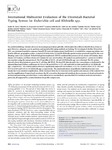International Multicenter Evaluation of the DiversiLab Bacterial Typing System for Escherichia coli and Klebsiella spp
| dc.contributor.author | Voets, GM | |
| dc.contributor.author | Leverstein-van Hall, MA | |
| dc.contributor.author | Kolbe-Busch, S | |
| dc.contributor.author | van der Zanden, A | |
| dc.contributor.author | Church, D | |
| dc.contributor.author | Kaase, M | |
| dc.contributor.author | Grisold, A | |
| dc.contributor.author | Upton, M | |
| dc.contributor.author | Cloutman-Green, E | |
| dc.contributor.author | Cantón, R | |
| dc.contributor.author | Friedrich, AW | |
| dc.contributor.author | Fluit, AC | |
| dc.date.accessioned | 2018-03-10T10:16:12Z | |
| dc.date.available | 2018-03-10T10:16:12Z | |
| dc.date.issued | 2013-12 | |
| dc.identifier.issn | 0095-1137 | |
| dc.identifier.issn | 1098-660X | |
| dc.identifier.uri | http://hdl.handle.net/10026.1/11056 | |
| dc.description.abstract |
<jats:title>ABSTRACT</jats:title> <jats:p> Successful multidrug-resistant clones are increasing in prevalence globally, which makes the ability to identify these clones urgent. However, adequate, easy-to-perform, and reproducible typing methods are lacking. We investigated whether DiversiLab (DL), an automated repetitive-sequence-based PCR bacterial typing system (bioMérieux), is suitable for comparing isolates analyzed at different geographic centers. A total of 39 <jats:named-content content-type="genus-species">Escherichia coli</jats:named-content> and 39 <jats:named-content content-type="genus-species">Klebsiella</jats:named-content> species isolates previously typed by the coordinating center were analyzed. Pulsed-field gel electrophoresis (PFGE) confirmed the presence of one cluster of 6 isolates, three clusters of 3 isolates, and three clusters of 2 isolates for each set of isolates. DL analysis was performed in 11 centers in six different countries using the same protocol. The DL profiles of 425 <jats:named-content content-type="genus-species">E. coli</jats:named-content> and 422 <jats:named-content content-type="genus-species">Klebsiella</jats:named-content> spp. were obtained. The DL system showed a lower discriminatory power for <jats:named-content content-type="genus-species">E. coli</jats:named-content> than did PFGE. The local DL data showed a low concordance, as indicated by the adjusted Rand and Wallace coefficients (0.132 to 0.740 and 0.070 to 1.0 [ <jats:named-content content-type="genus-species">E. coli</jats:named-content> ] and 0.091 to 0.864 and 0.056 to 1.0 [ <jats:named-content content-type="genus-species">Klebsiella</jats:named-content> spp.], respectively). The central analysis showed a significantly improved concordance (0.473 to 1.0 and 0.290 to 1.0 [ <jats:named-content content-type="genus-species">E. coli</jats:named-content> ] and 0.513 to 0.965 and 0.425 to 1.0 [ <jats:named-content content-type="genus-species">Klebsiella</jats:named-content> spp.], respectively). The misclassifications of profiles for individual isolates were mainly due to inconsistent amplification, which was most likely due to variations in the quality and amounts of the isolated DNA used for amplification. Despite local variations, the DL system has the potential to indicate the occurrence of clonal outbreaks in an international setting, provided there is strict adherence to standardized, reproducible DNA isolation methods and analysis protocols, all supported by a central database for profile comparisons. </jats:p> | |
| dc.format.extent | 3944-3949 | |
| dc.format.medium | Print-Electronic | |
| dc.language | en | |
| dc.language.iso | eng | |
| dc.publisher | American Society for Microbiology | |
| dc.subject | DNA, Bacterial | |
| dc.subject | Escherichia coli | |
| dc.subject | Humans | |
| dc.subject | International Cooperation | |
| dc.subject | Klebsiella | |
| dc.subject | Molecular Typing | |
| dc.subject | Polymerase Chain Reaction | |
| dc.subject | Reproducibility of Results | |
| dc.title | International Multicenter Evaluation of the DiversiLab Bacterial Typing System for Escherichia coli and Klebsiella spp | |
| dc.type | journal-article | |
| dc.type | Article | |
| plymouth.author-url | https://www.ncbi.nlm.nih.gov/pubmed/24025914 | |
| plymouth.issue | 12 | |
| plymouth.volume | 51 | |
| plymouth.publication-status | Published | |
| plymouth.journal | Journal of Clinical Microbiology | |
| dc.identifier.doi | 10.1128/jcm.01664-13 | |
| plymouth.organisational-group | /Plymouth | |
| plymouth.organisational-group | /Plymouth/Faculty of Health | |
| plymouth.organisational-group | /Plymouth/Faculty of Health/School of Biomedical Sciences | |
| plymouth.organisational-group | /Plymouth/REF 2021 Researchers by UoA | |
| plymouth.organisational-group | /Plymouth/REF 2021 Researchers by UoA/UoA01 Clinical Medicine | |
| plymouth.organisational-group | /Plymouth/Research Groups | |
| plymouth.organisational-group | /Plymouth/Research Groups/Institute of Translational and Stratified Medicine (ITSMED) | |
| plymouth.organisational-group | /Plymouth/Research Groups/Institute of Translational and Stratified Medicine (ITSMED)/CBR | |
| plymouth.organisational-group | /Plymouth/Research Groups/Plymouth Institute of Health and Care Research (PIHR) | |
| plymouth.organisational-group | /Plymouth/Users by role | |
| plymouth.organisational-group | /Plymouth/Users by role/Academics | |
| plymouth.organisational-group | /Plymouth/Users by role/Researchers in ResearchFish submission | |
| dc.publisher.place | United States | |
| dc.identifier.eissn | 1098-660X | |
| dc.rights.embargoperiod | Not known | |
| rioxxterms.versionofrecord | 10.1128/jcm.01664-13 | |
| rioxxterms.licenseref.uri | http://www.rioxx.net/licenses/all-rights-reserved | |
| rioxxterms.type | Journal Article/Review |


